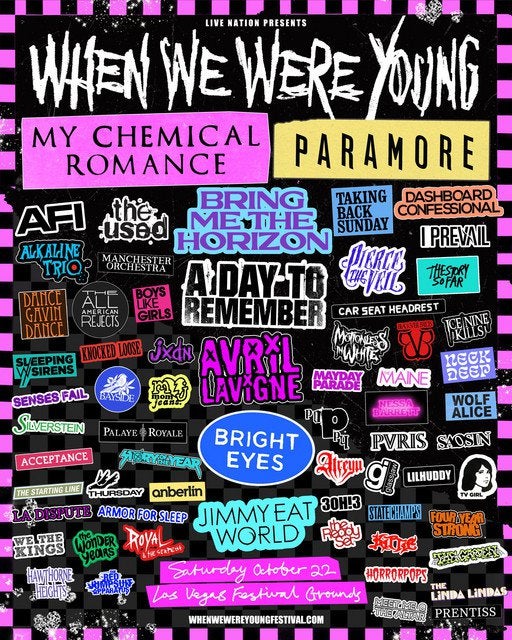Will WWWYF be Astroworld part two?
February 5, 2022
Do you remember how old you were the first time you heard “I Write Sins Not Tragedies” by Panic! At the Disco? Can you recognize My Chemical Romance’s “Welcome to the Black Parade” just from the first note? Do you suddenly find yourself giving arena-worthy performances to your bedroom walls whenever “Misery Business” by Paramore comes on shuffle?
If any of these rang true for you, then you’ve likely already heard of the When We Were Young Festival coming to Las Vegas on October 22nd, 23rd, and 29th, with a nostalgia-inducing lineup of some of the hugest emo bands of the early- and mid-2000’s. Along with the three bands mentioned above, the event also features The All-American Rejects, Bring Me the Horizon, and Pierce the Veil, just to name a few. In total, the lineup features 65 bands performing across three different stages. Each act will perform all three days of the festival, giving attendees plenty of opportunity to bask in the emo nostalgia at what fans are calling “Warped Tour 2.0.”
With many of the acts featured having sold out arenas by themselves, the price to see them all at one festival is appropriately steep. One general admission ticket starts at $225–and that’s just for one day. To attend another day of the festival, you would have to buy another full-price ticket. Thankfully, the company organizing the festival is offering a payment plan for tickets, with down payments starting at just $19.99.
Speaking of the company behind the festival, just who is responsible for making our middle school selves’ (and let’s be honest, current selves’) dream concert lineup a reality? None other than the company behind the Astroworld Festival, an event that made headlines last year after negligent management led to a crowd rush that killed ten people, one of whom was a nine-year-old boy.
The company, Live Nation, is the world’s largest live-events organizer, but many had never heard of them until Astroworld. Even today, the word “Astroworld” is far more recognizable to people than “Live Nation,” and that’s not by accident. The company does its best to fly under the radar of the public, because if people put all the blame on individual events, like Astroworld, instead of the company behind them, it is easy to gloss over the fact that, according to NPR, Live Nation has been connected to around 200 deaths and 750 injuries at their events since 2006.
In 2017, 22 people were killed by a suicide bomber at an Ariana Grande concert in Manchester, England. Despite the string of deadly attacks that were happening in Britain at that time, the BBC reported no extra security precautions were taken by staff at the Manchester venue. In fact, two of the on-duty officers left the venue for two hours just prior to the bombing. Later that same year, a mass shooting at the Route 91 Harvest festival in Las Vegas, promoted by Live Nation, killed 59 people. Going back further, during Radiohead’s North American tour in 2012, crew members were setting up for the concert when the stage collapsed, and a 6,000 pound video monitor fell on their drum technician, instantly killing him. This led the Ontario Ministry of Labor to bring charges against Live Nation, who later asked the court to throw out the charges in 2016 and were denied. They’ve had numerous citations filed against them by The Occupational Safety and Health Administration (OSHA) regarding different incidents.
Some speculative fans claim that the sudden announcement of the When We Were Young Festival is Live Nation’s attempt at recouping funds to cover their Astroworld lawsuits. However, despite being the target of numerous lawsuits over the years, Live Nation has failed to take a considerable hit. As mentioned, they are responsible for most of the world’s live concert events, including big-name artists. In 2020, the year before Astroworld, they pulled in over 1.86 billion dollars. The company’s stocks have risen steadily since the start of the pandemic while smaller venues and companies struggle to stay afloat during COVID restrictions.
The company is not above placing profit above human safety, and the When We Were Young festival is no different. Although COVID cases have been on the rise, they have done little to protect festival-goers. Masks are optional, tests aren’t required, and participants do not have to be vaccinated to gain entry. According to a notice posted on the festival’s website, “By attending When We Were Young, you voluntarily assume all risks related to exposure to COVID-19.”
World events aside, others want to know how 65 artists plan to perform on 3 stages in just 12 hours. Calculating the math totals out to around 35 minutes per artist, including the time it will take to set up and tear down their instruments. The festival, originally announced for just one day, drew hefty criticism. However, the festival sold out in just a few days and a second date was later added. After the second one sold out, a third date was scheduled for October 29th–six days apart from the other two shows. Live Nation also confirmed that more in-demand acts will have longer sets while smaller acts have shorter. This means bands like The Linda Lindas, made up of four girls between ages 11 and 17, are going to be in Las Vegas for six days waiting to play a ten-minute set, most of which will be spent setting up their instruments.
There are no shortage of reasons for potential concert-goers to have doubts about the When We Were Young Festival, but there are still plenty of fans who are brimming with excitement at the thought of seeing all their favorite bands in one place. Thus far, the discussion around it has been black or white: people are either calling it the best thing to ever happen or a disaster in the making. But whether it turns out to be Warped Tour 2.0 or the emo equivalent to “Fyre Fest,” a 2017 festival that failed to live up to its hype, remains to be seen. In the meantime, we should avoid jumping to either side. As a wise man once said, it’s much better to face these kinds of things with a sense of poise and rationality.



